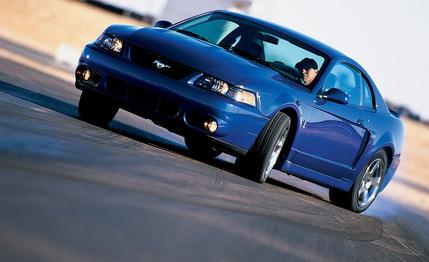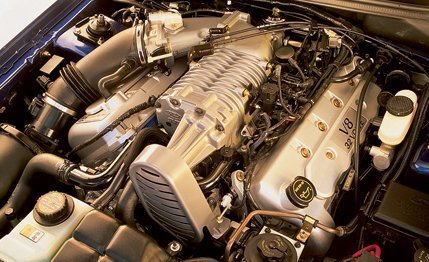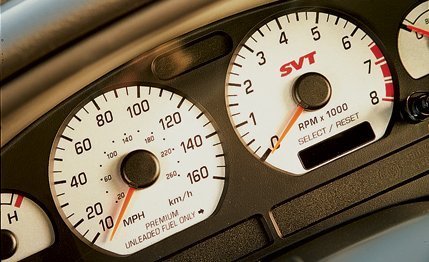
 Road Test
Road Test


One of the four prototype '03 SVT Mustang Cobras at Firebird International Raceway outside Phoenix, Arizona, had just completed an eight-hour durability run. So it was still tricked out with five-point harnesses, a full roll cage, and comprehensive telemetry hookups. Better yet, it had a cool racing seat that provided more legroom than Ford's standard Lear seat does.
For any test driver with 34-inch inseams, that's as good as a gilt-edged invitation to go play racing. Oh, and did we mention that we also had one of Firebird raceway's handling tracks at our disposal? Plus a supply of wheels and tires, a truck full of brake pads, and a bunch of Ford guys to do the wrenching? Big fun. All in the name of honest investigative journalism, of course.
Of course. But it wouldn't have been as much fun if Ford's Special Vehicle Team engineers hadn't nailed the new '03 Mustang Cobra's chassis calibrations right in the sweet spot. Or if they'd refrained from bolting the same big Eaton blower used in their F-150 Lightning super-pickup under the Mustang's hood, ratcheting the car's output to 390 horsepower and an equal measure of torque.


You might remember that SVT made some power claims in the past that weren't confirmed by results at the test track. This time, the team overcame what we understand to be the fundamental issue with Ford's high-performance modular engines: They are starved of intake air.
To circumvent that little issue, SVT now blows air into the four-valve heads from an engine-driven pump. End of problem. Naturally, you can't just go bolting superchargers onto engines and assume that'll do the trick. Not if you're a major motor manufacturer with warranty commitments.
So it took an extensive development program to produce the 2003 SVT Mustang Cobra, during which it was decided to base the engine on a cast-iron version of the 4.6-liter V-8's block. As in the SVT F-150 Lightning pickup, the iron block promises better durability in the heavy-duty environment of a high-torque drivetrain.
Inside the iron block, we find the previous Cobra's forged steel crank fitted with forged H-beam connecting rods from Manley. Revised aluminum heads and dished-top pistons drop the compression ratio to 8.5:1 to tolerate the higher combustion pressures encountered during maximum supercharger boost (up to eight pounds). A water-to-air intercooler condenses the induction charge for optimal performance.
To match the supercharged power characteristics, SVT reprofiled the camshafts for maximum low-rev torque—and to great effect, as we found out. Take a look at our street-start (5 to 60 mph) figure of just 4.9 seconds. Remember, that's a launch initiated with the clutch fully engaged, with the engine turning over at very low revs, yet it's only 0.4 second slower than the quickest standing-start launch we could manage.


Speaking of clutches, SVT fitted an 11-inch unit similar to that previously encountered in the Cobra, but with increased clamping force to cope with the higher torque output. The clutch marries this new strong V-8 to a six-speed Tremec T-56 gearbox.
An aluminum driveshaft connects the six-speed box to the rear axle, where a limited-slip diff with a 3.55:1 final-drive ratio resides in an aluminum case. That case is attached to a new tubular cross brace that is part of a revised independent-rear-suspension subframe. Bushing, mount, and spring rates are all-new, and the rear geometry has been revised to reduce roll steer.
Monotube Bilstein shocks, which provide better response to suspension deflections, according to SVT chief engineer John Coletti, are fitted at all four corners. For the first time, coupe and convertible Cobras have different spring rates to deal with their specific structures and applications. Both models get new five-spoke cast-alloy wheels with nine-inch rim widths (up one inch), and they wear impressive 275/40ZR-17 Goodyear Eagle F1 rubber.